Annotation by Richard Bleksley (Images added by SJB)
The man who walked towards the music
The Fender Stratocaster guitar is one of the enduring icons of rock music. It is probably what most people visualise on hearing the phrase “electric guitar.”
Rather than being an established musical instrument maker like (for example) Gibson, Leo Fender’s background was in radio and electronics (he didn’t even play the guitar himself), so his design approach was from the electronics end rather than the guitar end. Untrammelled by tradition and convention, he set about constructing a pure electric guitar from the ground up, designing it to be mass-produced and incorporating such heretical features as a detachable bolt-on neck.
Much of the instrument’s enduring popularity is probably due to its versatility. Its three pick-ups (most guitars have two), enable it to produce a wide range of sounds, including some that are difficult if not impossible to extract from any other guitar; and other famous Stratocaster-wielders include such diverse musicians as Hank Marvin, Eric Clapton, Richard Thompson, David Gilmour and Mark Knopfler.
Such is its popularity that a whole sub-section of the guitar industry is devoted to producing Stratocaster clones, incorporating modifications and improvements on the original, but the true Fender still outsells them all.
So the man who walked towards the music
And as the sea is in touch with a sea-shell
Cataclysmic on the floorboards of the evening
Looking much like a slightly heftier Stratocaster with two strings missing (actually the “Strat’s” body design was based on the Precision’s), it is a classic example of “the original and still the best,” for it is to this day the most popular bass in the world by far – there are probably more Precisions being played than all other types of electric bass put together.
“Marshall stack” refers to the classic configuration of two square Marshall speaker cabinets, one on top of the other, each containing four twelve inch speakers (known as a “four by twelve”), with a (usually) 100 watt Marshall amp on top of the lot. Its invention is credited to Pete Townshend of the Who, for whom Jim Marshall had created a massive eight by twelve cabinet. Loving the sound but finding it too unwieldy to transport, Townshend suggested that it be cut into two, thus creating the classic Marshall stack.
Marshall amplifiers and speakers continue to be very widely used, even in the USA.
So the man who walked towards the music
And as the sea is in touch with a sea-shell
He thought that Rickenbacker was a pilot
Probably still the best-known Rickenbacker player was John Lennon, who, right up until the Beatles’ late years, was seldom seen with anything else. Rickenbacker’s innovative 12-string electric (introduced 1964) also gained fame in the hands of Roger McGuinn, being responsible for the Byrds’ distinctive “jangly” sound. Their guitars fell out of favour in the seventies, but underwent a revival in the hands of new wave and indie musicians, with whom they continue to be popular.
Gretsch also have a well-respected line in drums.
In 1945 or –6, he approached the Gibson company with his design for a solid body electric guitar; but Gibson, proud of their reputation as traditional instrument makers (the company was founded in 1902, initially making mandolins) turned him down, wishing to have nothing to do with something so “crude.” They had already introduced in 1936 the ES-150 (as used by Charlie Christian to out-play the saxes), the first commercially successful electric guitar, but this was essentially one of their normal f-hole cello-back acoustics with a pick-up added.
This heavy construction, together with the “humbucking” pick-ups (in which two pick-ups of opposite polarities are mounted together under a single cover) give the Les Paul a richer, “thicker” sound than the Stratocaster and remarkable powers of sustain. It is not so versatile as the “Strat,” though, and tends to be favoured more by players at the heavier and bluesier end of the rock spectrum.
Gibson dropped the Les Paul in 1960 in favour of the lighter (and cheaper) shape that has been known since 1962 as the SG, but the work of white blues players like Mike Bloomfield, Peter Green and Eric Clapton (John Mayall’s “Beano” album featuring EC is possibly the classic example of “the Les Paul sound”) caused a resurgence of interest, and it was reissued in 1968, remaining in production ever since. Rather predictably, there arose a school of opinion that the new Les Pauls were not as good as the old ones, and “originals” now sell at astronomical prices.
Les Paul himself is still (2005) performing. He quips: “When I introduce myself to people, they are always surprised to learn that I’m not a guitar and not dead!”
Among the most prestigious of the many awards Kurosawa received were the Légion d’Honneur (1984) and a lifetime achievement Oscar (1990).
“Natasha liked the ball” is a reference to Leo Tolstoy’s War and Peace, as was discussed some years back on the mailing list. I’m afraid I have never read War and Peace, so I have nothing to add.
So the man who walked towards the music
And as the sea is in touch with a sea-shell
He could hear the drumming distance
Had never heard a noise like that before
He didn’t know a Stratocaster from a nuclear disaster
But he liked the floating notes and couldn’t wait to hear some more
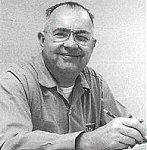
![]()
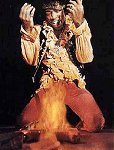 Fender’s first guitar, the Broadcaster (quickly renamed the Telecaster and still in production), introduced in 1950, still bore some resemblance to a traditional guitar; but when the Stratocaster followed in 1954, with its twin-horn body, it must have seemed like something from outer space. The first famous artist to be associated with the “Strat” was Buddy Holly, but the player who really set its reputation alight was Jimi Hendrix.
Fender’s first guitar, the Broadcaster (quickly renamed the Telecaster and still in production), introduced in 1950, still bore some resemblance to a traditional guitar; but when the Stratocaster followed in 1954, with its twin-horn body, it must have seemed like something from outer space. The first famous artist to be associated with the “Strat” was Buddy Holly, but the player who really set its reputation alight was Jimi Hendrix.
Asked the girl who was dancing in the dark
Who the band was that was playing
But the girl just kept on swaying
In the sea of sound that ran beneath the stars across the park
Singing so far and yet so near
He could hear the drumming distance coming close beside his ear
Precision basses thumped through Marshall stacks
And the echoes and reverbs, ultrasonic spice and herbs
Made his uptight mental trolley come alive and jump the tracks

![]() The Fender Precision Bass, made on the same principles as their guitars, was introduced in 1951. The first bass guitar in production, its concept was even more radical, and its effect on popular music even more profound, than Fender’s guitars. Much easier to transport and play than the upright double bass, it produces a louder, cleaner, more precise (hence the name?) sound. In competition with a big band or amplified instruments, the double bass can be heard as little more than a rhythmic thud, but an electric bass guitar always produces a clearly audible musical note.
The Fender Precision Bass, made on the same principles as their guitars, was introduced in 1951. The first bass guitar in production, its concept was even more radical, and its effect on popular music even more profound, than Fender’s guitars. Much easier to transport and play than the upright double bass, it produces a louder, cleaner, more precise (hence the name?) sound. In competition with a big band or amplified instruments, the double bass can be heard as little more than a rhythmic thud, but an electric bass guitar always produces a clearly audible musical note.
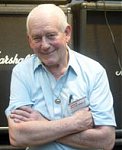
![]()
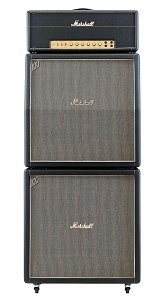 One of the few examples of legendary rock hardware to originate in Britain, Marshall Amplication was founded in 1964 in a small electronics shop in West London. Legend has it that, fed up with repairing amplifiers blown up by their owners’ obsessive quest for more volume, Jim Marshall decided to design an amp that could be overdriven without blowing up. Appropriately enough, the Who were among his earliest customers. Jimi Hendrix and Eric Clapton were also early users who helped to spread Marshall’s reputation.
One of the few examples of legendary rock hardware to originate in Britain, Marshall Amplication was founded in 1964 in a small electronics shop in West London. Legend has it that, fed up with repairing amplifiers blown up by their owners’ obsessive quest for more volume, Jim Marshall decided to design an amp that could be overdriven without blowing up. Appropriately enough, the Who were among his earliest customers. Jimi Hendrix and Eric Clapton were also early users who helped to spread Marshall’s reputation.
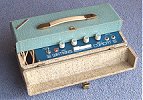
![]() Leaving aside technical definitions from acoustic science, in rock music reverb (or reverberation) is an electronically produced multiple echo effect, one of the oldest of the many sound-distorting devices used by rock musicians over the years. Bo Diddley, who was much given to experimenting with electronic gadgetry, used it on many of his classic records in the fifties.
Leaving aside technical definitions from acoustic science, in rock music reverb (or reverberation) is an electronically produced multiple echo effect, one of the oldest of the many sound-distorting devices used by rock musicians over the years. Bo Diddley, who was much given to experimenting with electronic gadgetry, used it on many of his classic records in the fifties.
Asked the girl who was dancing in the dark
Who the band was that was playing
But the girl just kept on swaying
In the sea of sound that ran beneath the stars across the park
Singing so far and yet so near
He could hear the drumming distance coming close beside his ear
He didn’t know a Gretsch from a Les Paul
He couldn’t tell a wah-wah from Akira Kurusawa
But he liked the way they played the way Natasha liked the ball

![]() Edward “Eddie” Rickenbacker (1890 - 1973) was the top American fighter ace of World War I, with 26 confirmed victories. In the years immediately before and after the war he was also one of America’s best known and successful racing drivers. After an unsuccessful foray into car manufacturing (it is said that the venture was sabotaged by a consortium of established manufacturers, afraid that the glamour of his name would affect their sales) he became owner and president of the Indianapolis Speedway in 1927, running it until 1947. His main business interest, though, was Eastern Airlines, which he helped to found and effectively ran until 1963.
Edward “Eddie” Rickenbacker (1890 - 1973) was the top American fighter ace of World War I, with 26 confirmed victories. In the years immediately before and after the war he was also one of America’s best known and successful racing drivers. After an unsuccessful foray into car manufacturing (it is said that the venture was sabotaged by a consortium of established manufacturers, afraid that the glamour of his name would affect their sales) he became owner and president of the Indianapolis Speedway in 1927, running it until 1947. His main business interest, though, was Eastern Airlines, which he helped to found and effectively ran until 1963.
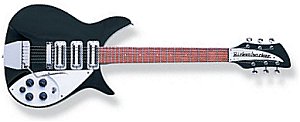 Rickenbacker, founded in 1931 as the Electro String Instrument Corporation, were the makers of the very first solid body electric guitars; but these were “Hawaiian” style rather than “Spanish” style instruments, designed to be played flat on the lap and the ancestors of those pedal steel guitars so beloved of country musicians. It was not until the rock-and-roll boom in the fifties that Rickenbacker began to produce conventional guitars.
Rickenbacker, founded in 1931 as the Electro String Instrument Corporation, were the makers of the very first solid body electric guitars; but these were “Hawaiian” style rather than “Spanish” style instruments, designed to be played flat on the lap and the ancestors of those pedal steel guitars so beloved of country musicians. It was not until the rock-and-roll boom in the fifties that Rickenbacker began to produce conventional guitars.

![]() Rickenbacker electric basses also have a considerable following, probably second only to the Fender Precision. Their popularity peaked in the seventies (just when the guitars were at their lowest ebb), but they continue to be widely used. Even Macca has been known to be wooed away from his beloved Hofner from time to time.
Rickenbacker electric basses also have a considerable following, probably second only to the Fender Precision. Their popularity peaked in the seventies (just when the guitars were at their lowest ebb), but they continue to be widely used. Even Macca has been known to be wooed away from his beloved Hofner from time to time.
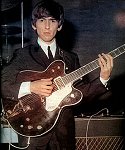 Gretsch is an old-established (1883) musical instrument manufacturer. Their guitars have traditionally been most favoured by country and rockabilly players (Eddie Cochran used one), but have never been as popular as Fenders or Gibsons in rock music. Their high point came in the sixties, when George Harrison used their Country Gentleman model throughout the years of Beatlemania. Sales slumped in the seventies and production ceased subsequent to the firm being sold; but the Gretsch family reacquired the business in 1989 and Gretsch guitars are once again with us.
Gretsch is an old-established (1883) musical instrument manufacturer. Their guitars have traditionally been most favoured by country and rockabilly players (Eddie Cochran used one), but have never been as popular as Fenders or Gibsons in rock music. Their high point came in the sixties, when George Harrison used their Country Gentleman model throughout the years of Beatlemania. Sales slumped in the seventies and production ceased subsequent to the firm being sold; but the Gretsch family reacquired the business in 1989 and Gretsch guitars are once again with us.
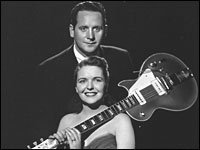
![]() Les Paul (1915 - ), real name Lester Polfus, as both guitarist and electronics whizz, was ideally placed to be a pioneer of the electric guitar. As a guitarist, he fronted his own trio, worked with artists such as Nat King Cole and Bing Crosby, and made a series of records featuring his wife, Mary Ford, on vocals. His home built electric guitar “The Log,” built in the 30’s and based on a length of four-by-four fence post, may have been the very first “Spanish” style solid guitar (see the Rickenbacker note above). On the electronics side, he built a recording studio in his garage, where he invented and pioneered such techniques as multi-tracking and overdubbing.
Les Paul (1915 - ), real name Lester Polfus, as both guitarist and electronics whizz, was ideally placed to be a pioneer of the electric guitar. As a guitarist, he fronted his own trio, worked with artists such as Nat King Cole and Bing Crosby, and made a series of records featuring his wife, Mary Ford, on vocals. His home built electric guitar “The Log,” built in the 30’s and based on a length of four-by-four fence post, may have been the very first “Spanish” style solid guitar (see the Rickenbacker note above). On the electronics side, he built a recording studio in his garage, where he invented and pioneered such techniques as multi-tracking and overdubbing.
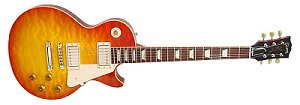 In the early fifties the burgeoning success of Fender guitars caused them to have a re-think, and Les Paul was invited back to collaborate with Gibson’s technicians in the design of a solid body guitar. Thus was born the Gibson Les Paul, introduced in 1952 and second in its iconic status only to the Stratocaster – though about the only thing they have in common is that both are electric guitars with solid bodies. Gibson would not compromise their high-quality, traditionalist image, and the Les Paul is “guitar-shaped” (even retaining the swell of Gibson’s traditional cello-back shape), beautifully crafted from expensive woods, and finished to a standard that wouldn’t disgrace a Rolls-Royce, in contrast to Fender’s factory approach. It is also very heavy.
In the early fifties the burgeoning success of Fender guitars caused them to have a re-think, and Les Paul was invited back to collaborate with Gibson’s technicians in the design of a solid body guitar. Thus was born the Gibson Les Paul, introduced in 1952 and second in its iconic status only to the Stratocaster – though about the only thing they have in common is that both are electric guitars with solid bodies. Gibson would not compromise their high-quality, traditionalist image, and the Les Paul is “guitar-shaped” (even retaining the swell of Gibson’s traditional cello-back shape), beautifully crafted from expensive woods, and finished to a standard that wouldn’t disgrace a Rolls-Royce, in contrast to Fender’s factory approach. It is also very heavy.

![]() The wah-wah pedal, which sweeps the peak response of a filter up and down in frequency to create the well-known “wah” sound, was popularised by Jimi Hendrix and Eric Clapton (with Cream), who both started using it in 1967, but the sound is much older than that. Jazz trumpeters were producing a similar sound with their mutes decades previously, and in fact the first record with a guitar wah-wah was made by Chet Atkins in 1960. The first British hit record with wah-wah (though used in a slower and gentler manner than later became general) was Dave Berry’s The Crying Game (1965).
The wah-wah pedal, which sweeps the peak response of a filter up and down in frequency to create the well-known “wah” sound, was popularised by Jimi Hendrix and Eric Clapton (with Cream), who both started using it in 1967, but the sound is much older than that. Jazz trumpeters were producing a similar sound with their mutes decades previously, and in fact the first record with a guitar wah-wah was made by Chet Atkins in 1960. The first British hit record with wah-wah (though used in a slower and gentler manner than later became general) was Dave Berry’s The Crying Game (1965).
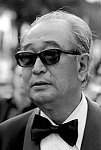 Akira Kurosawa (1910 - 1998), film producer, director and scriptwriter, is widely considered to have been the greatest of all Japanese film-makers. In a long career lasting from 1943 to 1993 he made around thirty films. As eclectic in his sources as he was widespread in his influence, he made (for example) two films based on Shakespeare plays, Macbeth (Throne of Blood, 1957) and King Lear (Ran, 1985), while films inspired by his work include The Magnificent Seven (The Seven Samurai, 1954), A Fistful of Dollars (Yojimbo, 1961) and the original Star Wars (The Hidden Fortress, 1958).
Akira Kurosawa (1910 - 1998), film producer, director and scriptwriter, is widely considered to have been the greatest of all Japanese film-makers. In a long career lasting from 1943 to 1993 he made around thirty films. As eclectic in his sources as he was widespread in his influence, he made (for example) two films based on Shakespeare plays, Macbeth (Throne of Blood, 1957) and King Lear (Ran, 1985), while films inspired by his work include The Magnificent Seven (The Seven Samurai, 1954), A Fistful of Dollars (Yojimbo, 1961) and the original Star Wars (The Hidden Fortress, 1958).
Asked the girl who was dancing in the dark
Who the band was that was playing
But the girl just kept on swaying
In the sea of sound that ran beneath the stars across the park
Singing so far and yet so near
He could hear the drumming distance coming close beside his ear
Coming closer, coming closer, coming closer
Coming close beside his ear
